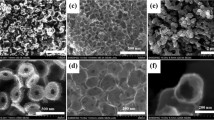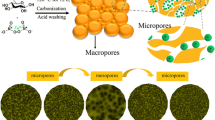Abstract
Porous carbon materials have been prepared by direct carbonization of potassium stearate in inert atmosphere without any further activation. The porous carbon materials exhibited a typical hierarchical pore size distribution, thereby rendering them the excellent supercapacitive performance. All electrochemical measurements were performed in a three-electrode system using 6 M KOH as the electrolyte. CK800 can deliver a high specific capacitance of 208 F g−1 (36.1 µF cm−2) at a current density of 0.5 A g−1. As the current density increased up to 30 A g−1, a high specific capacitance of 120 F g−1(20.8 µF cm−2) still can be maintained. 90.86 % of the specific capacitance was retained even after 5000 charge/discharge cycles at a current density of 2 A g−1.
Graphical Abstract










Similar content being viewed by others
References
Conway B (1999) Electrochemical supercapacitor. Scientific fundamentals and technological applications. Kluwer Academic/Plenum Publishers, New York
Sarangapani S, Tilak B, Chen CP (1996) Materials for electrochemical capacitors theoretical and experimental constraints. J Electrochem Soc 143(11):3791–3799
Miller JR, Simon P (2008) Electrochemical capacitors for energy management. Sci Mag 321(5889):651–652
Wang Y, Xia Y (2013) Recent progress in supercapacitors: from materials design to system construction. Adv Mater 25(37):5336–5342
Yan J, Wang Q, Wei T, Fan Z (2014) Recent advances in design and fabrication of electrochemical supercapacitors with high energy densities. Adv Energy Mater 4(4)
Zhang LL, Zhao X (2009) Carbon-based materials as supercapacitor electrodes. Chem Soc Rev 38(9):2520–2531
Gu W, Yushin G (2014) Review of nanostructured carbon materials for electrochemical capacitor applications: advantages and limitations of activated carbon, carbide-derived carbon, zeolite-templated carbon, carbon aerogels, carbon nanotubes, onion-like carbon, and graphene. Wiley Interdiscip Rev 3(5):424–473
Ahmadpour A, Do D (1996) The preparation of active carbons from coal by chemical and physical activation. Carbon 34(4):471–479
Maciá-Agulló J, Moore B, Cazorla-Amorós D, Linares-Solano A (2004) Activation of coal tar pitch carbon fibres: physical activation vs. chemical activation. Carbon 42(7):1367–1370
Zhao L, Fan LZ, Zhou MQ, Guan H, Qiao S, Antonietti M, Titirici MM (2010) Nitrogen-containing hydrothermal carbons with superior performance in supercapacitors. Adv Mater 22(45):5202–5206
Su F, Poh CK, Chen JS, Xu G, Wang D, Li Q, Lin J, Lou XW (2011) Nitrogen-containing microporous carbon nanospheres with improved capacitive properties. Energy Environ Sci 4(3):717–724
Ćirić-Marjanović G, Pašti I, Gavrilov N, Janošević A, Mentus S (2013) Carbonised polyaniline and polypyrrole: towards advanced nitrogen-containing carbon materials. Chem Pap 67(8):781–813
Xu B, Duan H, Chu M, Cao G, Yang Y (2013) Facile synthesis of nitrogen-doped porous carbon for supercapacitors. J Mater Chem A 1(14):4565–4570
Xu B, Zheng D, Jia M, Cao G, Yang Y (2013) Nitrogen-doped porous carbon simply prepared by pyrolyzing a nitrogen-containing organic salt for supercapacitors. Electrochim Acta 98:176–182
Luo H, Yang Y, Chen Y, Zhang J, Zhao X (2016) Structure and electrochemical performance of highly porous carbons by single-step potassium humate carbonization for application in supercapacitors. J Appl Electrochem 46:1–9
Puthusseri D, Aravindan V, Madhavi S, Ogale S (2014) 3D micro-porous conducting carbon beehive by single step polymer carbonization for high performance supercapacitors: the magic of in situ porogen formation. Energy Environ Sci 7(2):728–735
Sevilla M, Fuertes AB (2013) A general and facile synthesis strategy towards highly porous carbons: carbonization of organic salts. J Mater Chem A 1(44):13738–13741
Gregg SJ, Sing KSW, Salzberg H (1967) Adsorption surface area and porosity. J Electrochem Soc 114(11):279C–279C
Dollimore D, Spooner P, Turner A (1976) The BET method of analysis of gas adsorption data and its relevance to the calculation of surface areas. Surf Technol 4(2):121–160
Gregg S, Sing K (1982) Surface area and porosity. Academic Press, New York, p 248
Stoeckli H, Rebstein P, Ballerini L (1990) On the assessment of microporosity in active carbons, a comparison of theoretical and experimental data. Carbon 28(6):907–909
Zhang LL, Zhao X, Ji H, Stoller MD, Lai L, Murali S, Mcdonnell S, Cleveger B, Wallace RM, Ruoff RS (2012) Nitrogen doping of graphene and its effect on quantum capacitance, and a new insight on the enhanced capacitance of N-doped carbon. Energy Environ Sci 5(11):9618–9625
He X, Zhang H, Zhang H, Li X, Xiao N, Qiu J (2014) Direct synthesis of 3D hollow porous graphene balls from coal tar pitch for high performance supercapacitors. J Mater Chem A 2(46):19633–19640
Qie L, Chen WM, Wang ZH, Shao QG, Li X, Yuan LX, Hu XL, Zhang WX, Huang YH (2012) Nitrogen-doped porous carbon nanofiber webs as anodes for lithium ion batteries with a superhigh capacity and rate capability. Adv Mater 24(15):2047–2050
Kakaei K (2015) Decoration of graphene oxide with Platinum Tin nanoparticles for ethanol oxidation. Electrochim Acta 165:330–337
Wang Y, Su F, Wood CD, Lee JY, Zhao XS (2008) Preparation and characterization of carbon nanospheres as anode materials in lithium-ion secondary batteries. Ind Eng Chem Res 47(7):2294–2300
Kakaei K, Hasanpour K (2014) Synthesis of graphene oxide nanosheets by electrochemical exfoliation of graphite in cetyltrimethylammonium bromide and its application for oxygen reduction. J Mater Chem A 2(37):15428–15436
Gao S, Geng K, Liu H, Wei X, Zhang M, Wang P, Wang J (2015) Transforming organic-rich amaranthus waste into nitrogen-doped carbon with superior performance of the oxygen reduction reaction. Energy Environ Sci 8(1):221–229
Li Y, Wang H, Xie L, Liang Y, Hong G, Dai H (2011) MoS2 nanoparticles grown on graphene: an advanced catalyst for the hydrogen evolution reaction. J Am Chem Soc 133(19):7296–7299
Ferrari AC, Robertson J (2000) Interpretation of Raman spectra of disordered and amorphous carbon. Phys Rev B 61(20):14095
Kulkarni SB, Patil UM, Shackery I, Sohn JS, Lee S, Park B, Jun S (2014) High-performance supercapacitor electrode based on a polyaniline nanofibers/3D graphene framework as an efficient charge transporter. J Mater Chem A 2(14):4989–4998
Biniak S, Szymański G, Siedlewski J, Światkowski A (1997) The characterization of activated carbons with oxygen and nitrogen surface groups. Carbon 35(12):1799–1810
Datsyuk V, Kalyva M, Papagelis K, Parthenios J, Tasis D, Siokou A, Kallitsis I, Galiotis C (2008) Chemical oxidation of multiwalled carbon nanotubes. Carbon 46(6):833–840
Hulicova-Jurcakova D, Seredych M, Lu GQ, Bandosz TJ (2009) Combined effect of nitrogen-and oxygen-containing functional groups of microporous activated carbon on its electrochemical performance in supercapacitors. Adv Funct Mater 19(3):438–447
Thommes M, Kaneko K, Neimark AV, Olivier JP, Rodriguez-Reinoso F, Rouquerol J, Sing KS (2015) Physisorption of gases, with special reference to the evaluation of surface area and pore size distribution (IUPAC Technical Report). Pure Appl Chem 87(9–10):1051–1069
Zhou G, Wang D-W, Li F, Zhang L, Li N, Wu Z-S, Wen L, Lu GQ, Cheng H-M (2010) Graphene-wrapped Fe3O4 anode material with improved reversible capacity and cyclic stability for lithium ion batteries. Chem Mater 22(18):5306–5313
Jiang H-L, Liu B, Lan Y-Q, Kuratani K, Akita T, Shioyama H, Zong F, Xu Q (2011) From metal–organic framework to nanoporous carbon: toward a very high surface area and hydrogen uptake. J Am Chem Soc 133(31):11854–11857
Wang Y, Chang B, Guan D, Dong X (2015) Mesoporous activated carbon spheres derived from resorcinol-formaldehyde resin with high performance for supercapacitors. J Solid State Electrochem 19(6):1783–1791
Kishore B, Shanmughasundaram D, Penki TR, Munichandraiah N (2014) Coconut kernel-derived activated carbon as electrode material for electrical double-layer capacitors. J Appl Electrochem 44(8):903–916
Luo H-M, Yang Y-F, Sun Y-X, Zhao X, Zhang J-Q (2015) Preparation of lactose-based attapulgite template carbon materials and their electrochemical performance. J Solid State Electrochem 19(4):1171–1180
Huang M, Zhao XL, Li F, Li W, Zhang B, Zhang YX (2015) Synthesis of CO3 O4/SnO2@ MnO2 core–shell nanostructures for high-performance supercapacitors. J Mater Chem A
Fang D-L, Chen Z-D, Liu X, Wu Z-F, Zheng C-H (2012) Homogeneous growth of nano-sized β-Ni (OH)2 on reduced graphene oxide for high-performance supercapacitors. Electrochim Acta 81:321–329
Hulicova D, Kodama M, Hatori H (2006) Electrochemical performance of nitrogen-enriched carbons in aqueous and non-aqueous supercapacitors. Chem Mater 18(9):2318–2326
Acknowledgments
This study was supported by the National Natural Science Foundation of China (NSFC, No. 21364004) and the Provincial Natural Science Foundation of Gansu (No. 1506RJZA102).
Author information
Authors and Affiliations
Corresponding author
Rights and permissions
About this article
Cite this article
Luo, HM., Chen, H., Chen, YZ. et al. Simple synthesis of porous carbon materials for high-performance supercapacitors. J Appl Electrochem 46, 703–712 (2016). https://doi.org/10.1007/s10800-016-0958-9
Received:
Accepted:
Published:
Issue Date:
DOI: https://doi.org/10.1007/s10800-016-0958-9




